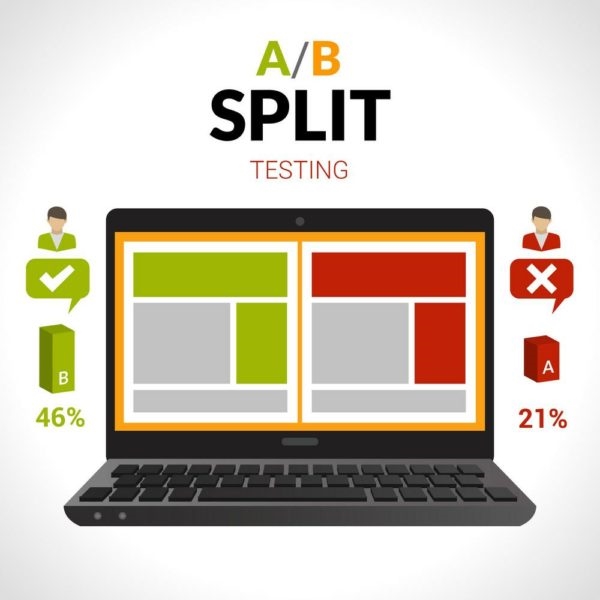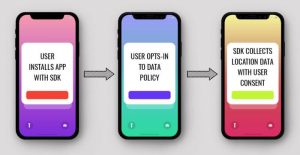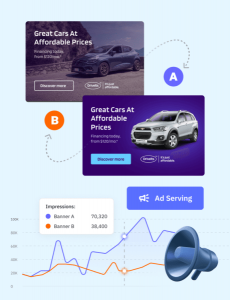When planning a new marketing campaign, the most valuable knowledge you can have is which strategies worked in your previous campaigns, and which didn’t. With that in mind, A/B testing is perhaps the most important practice for any marketer.
No matter whether you’re an amateur with a brand-new marketing strategy that isn’t providing the results you expected, or a veteran with a campaign plan that delivers every time, your campaigns always have the potential to improve, and there’s only one reliable way to achieve that.
The answer is split testing or A/B testing.
What is A/B Testing?

The simplest way to explain A/B testing, is that it involves testing which version of a marketing tool provides the greatest results.
An example is when you’re building a landing page for your website.
Building two separate landing pages and testing their performance data against each other can give you an objective idea of which one is likely to convert the most users and create the best impact.
Of course, once you know this, it’s best to retire the other version and make the winner your actual landing page.
But that doesn’t mean your A/B testing is done – why not try another version with everything you’ve learned taken into account, and test it against your original winner?
By doing this consistently over time, you can learn what works and what doesn’t, building on this knowledge each time, and ensuring your marketing content gets better and better over time.
But landing pages are just an example. A/B testing can help you understand your customers and master any marketing strategy, whether you’re optimizing an Amazon listing, building a website, designing a poster, or devising a video marketing campaign.
Since this is the area of marketing we’re most interested in, this is what we’re going to focus on today:
A/B Testing Video Marketing Campaigns
When A/B testing your video marketing campaigns, you can compare anything that may make a difference in terms of conversion rates or viewer behavior.
This includes:
- Titles and captions
- Colors and graphics
- Imagery
- Presenters/voiceovers
- CTA text and links
To avoid starting from zero, it’s a great idea to do some research first in order to figure out some of the commonly known ‘best practices’ that can get you started off in the right direction.
Great sources for this can be marketing blogs and authorities within the video marketing niche, but another invaluable source is your older campaigns and any data you have on their performance. If you have access to data on when users click off the video, you can even learn about what can turn off a viewer from your video and what can keep them glued to the screen.
Next, you should prioritize which elements to test first. These should be ranked based on the potential improvement they can provide, so any elements you think you’re lacking in are a good place to start. Although, you should also take into account how much time and resources particular elements will take to improve, and any risks that may be involved with this.
Try following these steps:
1. Decide which elements you’re going to test first: Take a look at your existing video content and past campaigns, in order to figure out which aspects need improving. Use analytics, video marketing blogs and the content created by the leaders of your niche in order to develop a theory on which aspects of your video content strategy could be improved, and the results these improvements should have on an overall campaign. Once you have a basic idea for this, rank the elements in order of priority.
2. Create two pieces of content using your theories: This stage simply involves creating two pieces of content, one that takes advantage of your new theory and one that does things the existing way. For example, if you are testing some new graphics for your videos, create one video with the new graphics and one with the previous ones. All other aspects of the content should be identical.
3. Run both campaigns side by side and measure performance: Before you begin, decide which metrics to track in order to measure effectiveness. For example, if you’re changing a thumbnail and title in order to increase the amount of people that watch a video, then measuring the amount of people that click and begin watching the video is likely enough. If you’re measuring the effectiveness of an explainer video to convert web users to customers, then you can calculate this by comparing the conversions on a page with one video compared to another. Your existing and previous performance will also provide a great baseline for this.
4. Learn from the results and implement changes: Once your test has been running for enough time, it’s time to compare the results. If the results aren’t conclusive or even identical, it’s perhaps time to try another test. However, if one of the two strategies you’re testing is obviously superior, it’s time to implement that strategy across the board. This should provide the improvement in performance you experienced between the two elements being tested, for all of your future content.
5. Run your next test: Of course, A/B testing is not very useful if you only do it once. You may find some minimal improvements, but the real benefit of split testing comes when you are constantly testing different elements against each other. Doing this allows you to identify different seasonal or conditional factors that may impact your results, cut out aspects of your campaigns that are ineffective, and constantly improve over time, leading to better and better results.
The elements you’re testing will of course vary depending on your organizations aims and goals. However, for video marketing campaigns specifically, there are a few that should always be on your radar:
- Video length. This can make all of the difference between attentive viewers who are taking in every piece of information, and bored viewers who couldn’t care less. Your aim is crucial here. An explainer video to help people understand how to use a service should only be between 10 seconds and 1 minute long to avoid boring the viewer or making the service seem complicated. Alternatively, an in-depth business proposal should be longer and more in depth to make it seem authoritative. The only real way to find out the ideal video length for a specific aim is A/B testing both lengths and seeing how they affect user interaction, engagement and conversions.
- Location or page. A video aimed at explaining your service and increasing business should probably be on the home page. It’s going to get considerably less views tucked away in a FAQs page. Although, a video explaining the answer to a specific question could do very well there. Luckily, this is one of the easiest things to split test as the only performance indicator you need to track is video views.
- Call to action. Do you get your video presenter to call out your service at the end? Or end the viewer on a silent text ad with a button? If the latter, what color should the button be? If the former, how long of a callout becomes too long for people to pay attention? All of these things should be taken into account when creating video content. Split testing your CTAs can mean your video marketing campaigns convert more and more people every time. If you’re improving your quality and quantity of videos at the same time, it’s difficult not to see growth.
To Conclude
Of course, creating a video is a time-consuming process. Still I am suggesting to A/B test it because if users don’t watch it, what’s the use of putting efforts. Also, videos have become the go-to content source for users. They are easily digestible, and thus, users prefer videos over other content sources. A/B testing videos increase your odds of achieving highest conversion and give you insights on how to create more valuable videos in future. From there on, your videos will turn on the constant flow of customers.
Digital & Social Articles on Business 2 Community
(79)







